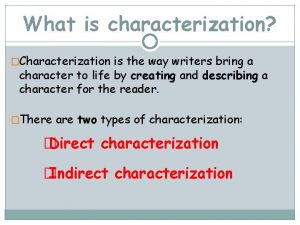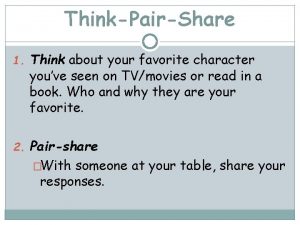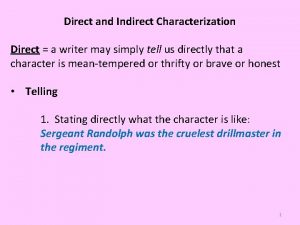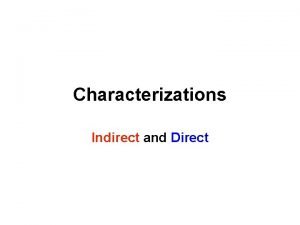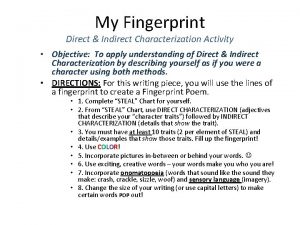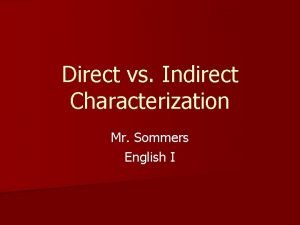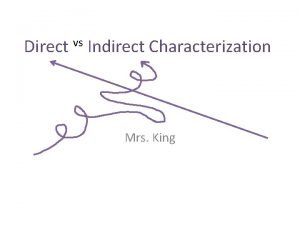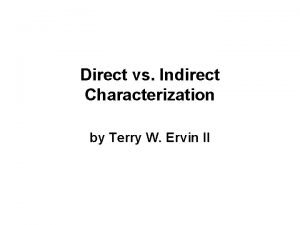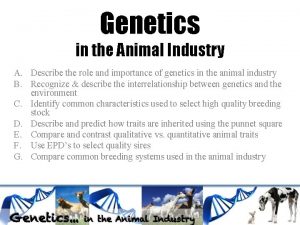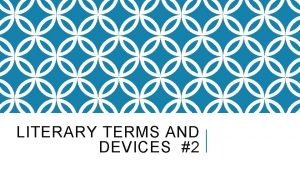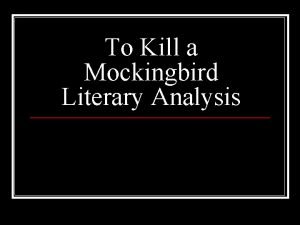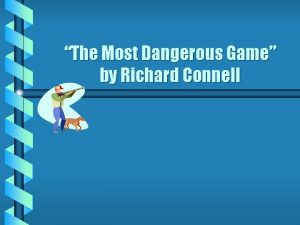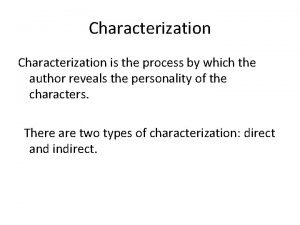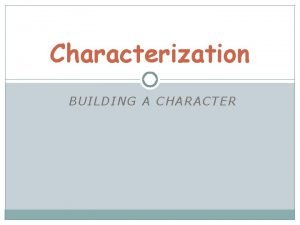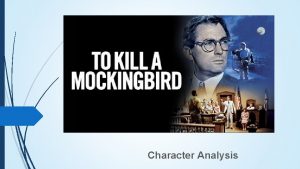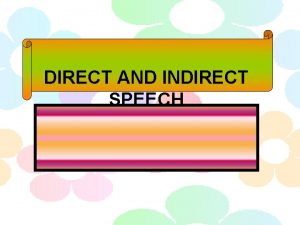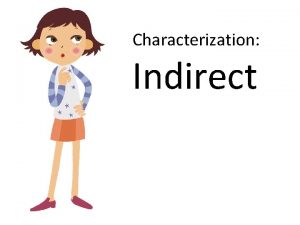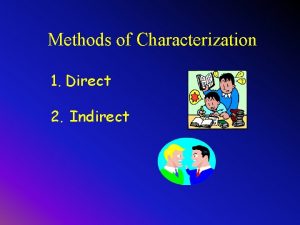Direct and Indirect Characterization Traits vs Emotions Emotions



































- Slides: 35

Direct and Indirect Characterization

Traits vs. Emotions • Emotions- Describe a character’s emotional response to things around them (temporary) • Traits- the qualities that make up who a character really is

Characterization • Characterization is what writers use to create and develop characters. • There are two types of characterization – Direct – Indirect

Direct Characterization • The writer directly states or describes the characters’ traits. • Example – “The new boy and quiet girl were at the basketball game together. ”

Indirect Characterization • You must make an INFERENCE based on a characters » Speech » Thoughts » Actions • What is an inference? – Educated guess based on clues provided

SPEECH • What does the character say? • How does the character speak? • Example – “Hey, we can have lots of fun at camp this summer! I love being outside!”

THOUGHTS • What is revealed through the character’s thoughts and feelings? • Example – “I wish it would stop raining! I am very tired of sitting inside! There is nothing to do!”

ACTIONS • What does the character do? • How does the character behave? • Example – The girl rode the lawn mower through the house and into the garage.

REMEMBER • The difference between direct characterization and indirect characterization is TELLING vs. SHOWING!!!

Your Turn 1. Determine if the example is direct/indirect characterization. 2. If the example is indirect characterization…. *Think about if it was the character’s speech, thoughts, or actions.

PRACTICE • Jim was an honest man. He never cheated anybody in his entire life.

PRACTICE • Jim was an honest man. He never cheated anybody in his entire life. DIRECT CHARACTERIZATION

PRACTICE • John cared a lot for the well being of others. There was an odd couple living alone near his house. John used to buy weekly groceries for them and even check on them everyday, just to see how they are doing.

PRACTICE • John cared a lot for the well being of others. There was an odd couple living alone near his house. John used to buy weekly groceries for them and even check on them everyday, just to see how they are doing. DIRECT CHARACTERIZATION

PRACTICE • Julie began fixing supper while the children played. First, she washed the romaine lettuce with grapefruit seed extract. Then she got out the mill to grind the corn. After it was ready, she used honey to replace the sugar in the recipe and put the cornbread in the oven. The dried beans were simmering in the crock pot. She washed and cut up the fresh strawberries they had picked that morning for dessert.

PRACTICE • Julie began fixing supper while the children played. First, she washed the romaine lettuce with grapefruit seed extract. Then she got out the mill to grind the corn. After it was ready, she used honey to replace the sugar in the recipe and put the cornbread in the oven. The dried beans were simmering in the crock pot. She washed and cut up the fresh strawberries they had picked that morning for dessert. INDIRECT CHARACTERIZATION ACTIONS – Through her actions, we see a conscientious mother concerned about the nutrition of her family. She cares enough to work harder in preparing meals the way she thinks is best.

PRACTICE • As he sat brooding in his room, Caleb thought of how his baby sister spoiled everything. He thought of how things used to be before she arrived. He wanted to go to Disney World and have fun for his fourth birthday! He got an idea. Buck, their neighbor, feeds the dogs when they go out of town, so Buck could come by and feed the baby when he came to feed the dogs. He loved to play with her, and he could do that. He got up to go tell his mother.

PRACTICE • As he sat brooding in his room, Caleb thought of how his baby sister spoiled everything. He thought of how things used to be before she arrived. He wanted to go to Disney World and have fun for his fourth birthday! He got an idea. Buck, their neighbor, feeds the dogs when they go out of town, so Buck could come by and feed the baby when he came to feed the dogs. He loved to play with her, and he could do that. He got up to go tell his mother. • INDIRECT CHARACTERIZATION THOUGHTS - Here we see thoughts of a little boy and his frustrations with his new baby sister and the solution he thought of to solve the problem!

PRACTICE • The husband was fussing at his wife. “That bag of lettuce is half empty! Why don’t you try to get one that had more in it? I can’t believe you didn’t look at the bag more carefully at the grocery store!”

PRACTICE • The husband was fussing at his wife. “That bag of lettuce is half empty! Why don’t you try to get one that had more in it? I can’t believe you didn’t look at the bag more carefully at the grocery store!” INDIRECT CHARACTERIZATION Speech – Through his words, the husband is characterized as picky and critical. The author doesn’t have to tell us these characteristics.

PRACTICE • Linda was a strong woman who lived her entire life on her own terms, without compromising and without ever being apologetic for anything.

PRACTICE • Linda was a strong woman who lived her entire life on her own terms, without compromising and without ever being apologetic for anything. DIRECT CHARACTERIZATION

PRACTICE #8 • After visiting my sister Megan, Bobby said, “She really knows how to get a lot of storage into every space, doesn’t she? ” “Yes, ” I answered. “Organizing is a fun challenge for her and is what she enjoys. She never stops, but keeps reorganizing in a better way!”

PRACTICE #8 • After visiting my sister Megan, Bobby said, “She really knows how to get a lot of storage into every space, doesn’t she? ” “Yes, ” I answered. “Organizing is a fun challenge for her and is what she enjoys. She never stops, but keeps reorganizing in a better way!” INDIRECT CHARACTERIZATION AFFECT ON OTHERS TOWARD THE CHARACTER – From this conversation between Frances and Jean’s sister, the reader gets a picture of Jean’s organizational skills.

Let’s Review… • characterization review

Video Clips • Watch the following video clips and determine whether it is showing direct or indirect characterization! Explain your reasoning for your selection.

Determining Direct & Indirect Characterization Through Video Clips Video Clip #1 Video Clip #2 DIRECT/INDIRECT Characterization DIRECT / INDIRECT Video Clip #3 Video Clip #4 Video Clip #5 Video Clip #6 DIRECT / INDIRECT/INDIRECT/INDIRECT How do you know?

Video Clip #1 • Mean Girls Clip 1

Video Clip #2 • Hunger Games – clip

Video Clip #3 • Twilight – video clip

Video Clip 4 Zootopia -Clip 4

Video Clip 5 Harry Potter and The Sorcerer’s Stone -Clip 5

Video Clip 6 The LEGO Batman Movie -Clip 6

Check Your Answers VIDEO CLIP DIRECT / INDIRECT CHARACTERIZATION Mean Girls DIRECT CHARACTERIZATION Hunger Games INDIRECT CHARACTERIZATION Twilight DIRECT CHARACTERIZATION Zootopia INDIRECT CHARACTERIZATION Harry Potter and the INDIRECT CHARACTERIZATION Sorcer’s Stone The LEGO Batman Movie DIRECT CHARACTERIZATION

PERFORMANCE TASK! 1. Choose a trait from the basket. 2. Create a short skit with your group (assigned by Mrs. Humbyrd) to indirectly show these traits to your classmates. You have approximately 5 -7 minutes to plan. 3. Make sure you demonstrate this trait through a characters thoughts, speech, or actions. 4. Your classmates will then infer what traits you are performing.
 Indirect characterization meaning
Indirect characterization meaning What is direct and indirect characterization
What is direct and indirect characterization Indirect characterization examples
Indirect characterization examples Indirect characterization thoughts examples
Indirect characterization thoughts examples Direct or indirect characterization
Direct or indirect characterization What is direct characterization
What is direct characterization Difference between indirect and direct characterization
Difference between indirect and direct characterization Direct and indirect characterization worksheet
Direct and indirect characterization worksheet Indirect characterization example
Indirect characterization example Indirect characterizations
Indirect characterizations Direct and indirect characterization
Direct and indirect characterization Indirect characterization
Indirect characterization Indirect vs. direct characterization
Indirect vs. direct characterization Characterization speech
Characterization speech Direct and indirect characterization activities
Direct and indirect characterization activities John proctor indirect characterization quotes
John proctor indirect characterization quotes Direct vs indirect characterization
Direct vs indirect characterization Direct and indirect characterization quiz
Direct and indirect characterization quiz Peddler's disguise
Peddler's disguise Direct vs indirect characterization
Direct vs indirect characterization Indirect characterization define
Indirect characterization define Direct versus indirect characterization
Direct versus indirect characterization Dynamic characters in pride and prejudice
Dynamic characters in pride and prejudice Quantitative traits
Quantitative traits Qualitative traits vs quantitative traits
Qualitative traits vs quantitative traits Qualitative traits vs quantitative traits
Qualitative traits vs quantitative traits Flat literary definition
Flat literary definition Direct characterization in tkam
Direct characterization in tkam Allusion in the most dangerous game
Allusion in the most dangerous game Direct characterization definition
Direct characterization definition Indirect characterization meaning
Indirect characterization meaning Indirect characterization thoughts examples
Indirect characterization thoughts examples Indirect characterization thoughts examples
Indirect characterization thoughts examples What does indirect characterization mean
What does indirect characterization mean What does steal mean in characterization
What does steal mean in characterization Short stories characterization
Short stories characterization


